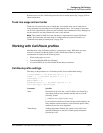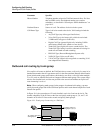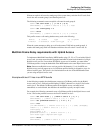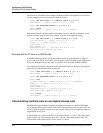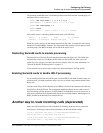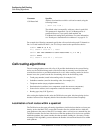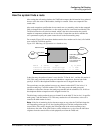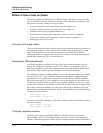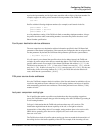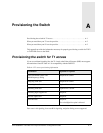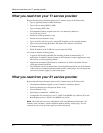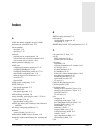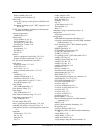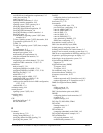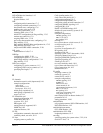
Configuring Call Routing
Call routing algorithms
APX 8000/MAX TNT/DSLTNT Physical Interface Configuration Guide Preliminary May 9, 2000 19-13
equal to the input number, and its digits must match the add-on digits of the input number. For
example, suppose the calling switch sent the following number to the TAOS unit:
555-1212
Profiles with the following telephone numbers (for example) would remain in the list:
phone-number = 1212
phone-number = 555-1212
phone-number = 12
As with subaddress routing, if the TAOS unit finds no matching telephone numbers, it drops
the profiles that have other, nonmatching numbers, but retains the profiles that have a null
Phone-Number specification.
Fourth pass: destination device addresses
The next comparison uses destination-address information specified in the Call-Route-Info
parameter of the channel configuration, if the network port configuration has an assigned value
for that parameter. By default, the Call-Route-Info parameter specifies the system address:
{ any-shelf any-slot 0 }
If a call comes in on a channel that specifies a host device address instead, the TAOS unit
excludes all profiles whose index does not match that address. The TAOS unit uses the most
specific address match. For example, if the channel Call-Route-Info address is { 1 5 1 }, the
TAOS unit uses the entry for { 1 5 1 }, if one exists. If there is no entry for { 1 5 1 }, uses the
entry for { 1 5 0 }. If there is no entry for { 1 5 0 }, it uses the entry for { 1 0 0 }. If it does not
find an entry in the call-routing database for { 1 0 0 }, the TAOS unit uses the default call
route, which has the system address, { 0 0 0 }.
Fifth pass: source device addresses
Next, the TAOS unit compares the device address of the line and channel on which the call was
received to the preferred source addresses in its call-routing database, and rejects all profiles
with nonmatching preferred source addresses. The default preferred-source address { 0 0 0 }
matches all calls.
Last pass: comparison routing type
For all profiles that remain as possible route destinations after the preceding comparison
passes, the TAOS unit compares the type of the incoming call to the Call-Route-Type setting in
its call-routing database.
Call type is information that the TAOS unit can detect about any call it receives. The
information might indicate the bearer capability of the call, or it might be related to
characteristics of the calling device. For example, analog modems place voice-service calls.
ISDN devices generally place data-service (digital) calls, but in some cases can place
data-over-voice calls.
The TAOS unit excludes all profiles whose routing type does not match the characteristics of
the calling device or the bearer capability of the call. For example, if the incoming call uses



